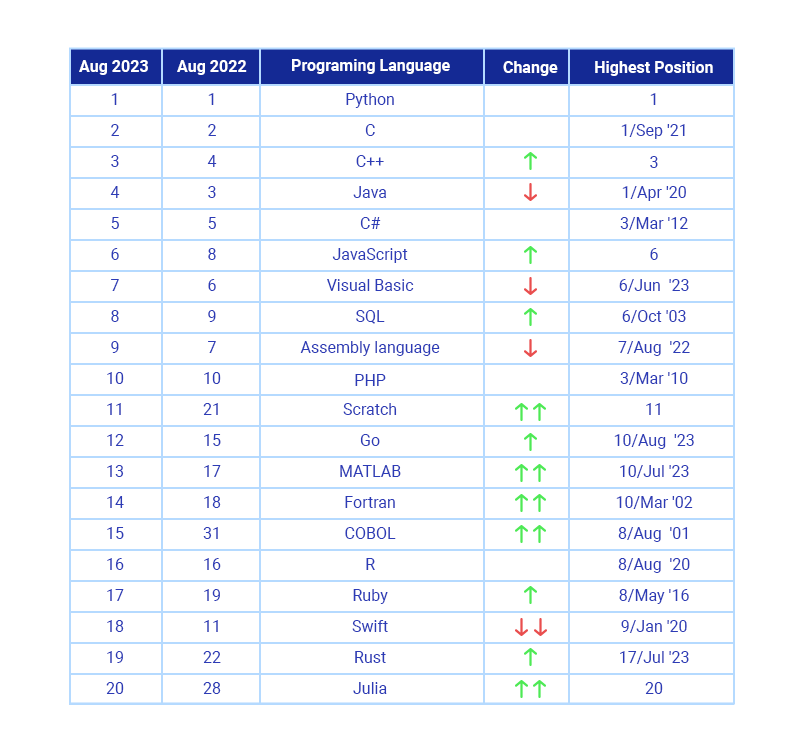TIOBE INDEX announced another ranking of the most popular programming languages in early August. There were no surprises again, as Python maintained its position as number one. It should be noted that, for the first time ever, Julia, a fairly young language mainly used for numerical calculations, has jumped into the top twenty of the index.
What is TIOBE Index?
TIOBE Index is one of the main sources of information on programming languages popularity. It is based on search engine results, i.a. Google, Bing, Yahoo!, Wikipedia, Amazon, YouTube and Baidu, discussion forums and other sources. The index is updated every month and, for many programmers and organisations, it is an indicator of which programming languages are most popular and which should be used when developing software.
At this point, it is worth noting the words of TIOBE Executive Director, Paul Jansen, who strongly emphasizes in many publications that “The index is not about which language is the best or in which the most lines of code have been created.”
The most popular programming languages – August 2023

Where does the success of Python lie?
At the beginning of 1991, the first version of Python was released in 0.9.0 version. The experts felt that this language will play a key role in the growing IT market right from the start. And they were right. Support for exceptions, functions and core data types, as well as functionality sharing mechanisms between classes, have caused the language to shoot up in development like a cannon and compete for the title of most popular programming language every year.
It is worth adding, that all Python versions belong to the Open Source software category. What is more, most of them (although not all) were or are compatible with GPL licence (General Public License).
The advantages of Python include:
- reasonably modern syntax with the option of choosing different programming paradigms (functional, object-oriented, reactive),
- large and friendly community, willing to share thoughts on StackOverflow,
- extensive collection of built-in and portable options,
- efficient communication with other parts of an application,
- cooperation between the most important platforms – it does not matter if we use Windows or Linux platform.
As for the very name, no, it is not named after the animal but it is derived from a sitcom emitted by BBC in the 1970s – “Monty Python’s Flying Circus”. The designer, being a fan of the series and looking for a short, unique and a bit mysterious name, thought this one was great. Did he succeed? We leave it to you to judge.
Changes on the podium
Language C, as popular as Python, retained its position as the second. In both cases, popularity of both languages dropped by, respectively, 2.3% and 3.35%. C++ is the only language that found the way to the podium and noted an increase for a year (+0,49%).
The fact that C and C++ languages, despite their very long history, are still very popular among IT professionals shouldn’t be too hard to spot. These are successfully used wherever very high performance with low resource consumption is needed.
Apparently, language C probably does not have “expiration date”. It was founded over 40 years ago but it is still one of the leaders in popularity rankings. In general, the language is seen as being used for two purposes: small microcontrollers programming and for operating systems and programmes that run very close to the operating system (e.g. device drivers). Language C++ is an excellent solution in games development and embedded systems. Its users include some of the world’s largest corporations: Adobe, Facebook, Amazon, Ericsson, HP, IBM and Intel.
A drop of one position compared to August 2022 was recorded by Java, but it does not detract from the fact that it is still one of the most popular languages in the world. And indisputably the top in terms of job offers in Poland.
Julia’s debut
Julia is quite a new language, developing since 2009, so that it could debut on the market in February, 2012. What, then, makes Julia special and deserving of a place in the top 20?
Julia is applied especially in the world of information science and mathematical calculations, while its special property is “repeated sending” that lets you to expand existing features and define custom and complex behaviour for new types. All right, but among the most popular programming languages we already have giants such as Python, R or MATLAB. Why, then, Julia?
Well, Julia is simply faster than Python, more suitable for writing large systems in it than R and cheaper than MATLAB. Thus, the rate, scalability and open source software make Julia an attractive alternative. However, to make things less colourful – it also has its drawbacks. Operating Julia requires much more programming skills than the other three languages mentioned. Will Julia then maintain its position between the “big brothers”? Let us know in the comments which place Julia will take in the next list of the most popular programming languages.